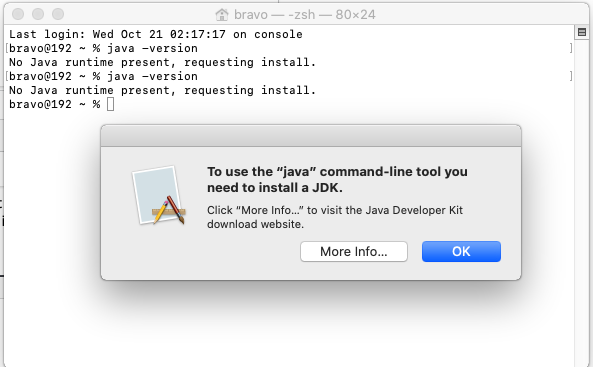

The property variable is a string with no spaces that represents the name of the property. The 64-bit version of the Java SE Development Kit (JDK) currently ignores this option and instead uses the Server JVM.įor default JVM selection, see Server-Class Machine Detection at -D property= value
#COMPILE JAVA MAC OS X FULL#
This option is equivalent to -agentlib but uses the full path and file name of the library. Loads the native agent library specified by the absolute path name. The package description at Īgent Command Line Options in the JVM Tools Interface guide at agentlib:jdwp=transport=dt_socket,server=y,address=8000įor more information about the native agent libraries, refer to the following:
#COMPILE JAVA MAC OS X HOW TO#
The following example shows how to load the Java Debug Wire Protocol (JDWP) library and listen for the socket connection on port 8000, suspending the JVM before the main class loads: agentlib:hprof=cpu=samples,interval=20,depth=3 The following example shows how to load the heap profiling tool (HPROF) library and get sample CPU information every 20 ms, with a stack depth of 3: If the option -agentlib:foo is specified, then the JVM attempts to load the library named libfoo.so in the location specified by the LD_LIBRARY_PATH system variable (on OS X this variable is DYLD_LIBRARY_PATH). After the library name, a comma-separated list of options specific to the library can be used. Loads the specified native agent library. These are the most commonly used options that are supported by all implementations of the JVM. If you are expected to specify the percentage, use a number from 0 to 1 (for example, specify 0.25 for 25%). For example, to set the size to 8 GB, you can specify either 8g, 8192m, 8388608k, or 8589934592 as the argument. If you are expected to specify the size in bytes, you can use no suffix, or use the suffix k or K for kilobytes (KB), m or M for megabytes (MB), g or G for gigabytes (GB).

#COMPILE JAVA MAC OS X PLUS#
Boolean -XX options are enabled using the plus sign ( -XX:+ OptionName) and disabled using the minus sign ( -XX:- OptionName).įor options that require an argument, the argument may be separated from the option name by a space, a colon (:), or an equal sign (=), or the argument may directly follow the option (the exact syntax differs for each option). To keep track of the options that were deprecated or removed in the latest release, there is a section named Deprecated and Removed Options at the end of the document.īoolean options are used to either enable a feature that is disabled by default or disable a feature that is enabled by default. They are also not guaranteed to be supported by all JVM implementations, and are subject to change. These are developer options used for tuning specific areas of the Java HotSpot Virtual Machine operation that often have specific system requirements and may require privileged access to system configuration parameters. These options start with -X.Īdvanced options are not recommended for casual use. Non-standard options are general purpose options that are specific to the Java HotSpot Virtual Machine, so they are not guaranteed to be supported by all JVM implementations, and are subject to change. They are used for common actions, such as checking the version of the JRE, setting the class path, enabling verbose output, and so on. Standard options are guaranteed to be supported by all implementations of the Java Virtual Machine (JVM).

The java command supports a wide range of options that can be divided into the following categories: The JRE searches for the startup class (and other classes used by the application) in three sets of locations: the bootstrap class path, the installed extensions, and the user's class path.Īrguments after the class file name or the JAR file name are passed to the main() method. The startup class must be indicated by the Main-Class manifest header in its source code. If the -jar option is specified, its argument is the name of the JAR file containing class and resource files for the application. In the latter case, the launcher constructs an instance of the Application class, calls its init() method, and then calls the start() method.īy default, the first argument that is not an option of the java command is the fully qualified name of the class to be called. The java command can be used to launch a JavaFX application by loading a class that either has a main() method or that extends.

The method declaration has the following form: The method must be declared public and static, it must not return any value, and it must accept a String array as a parameter. It does this by starting the Java Runtime Environment (JRE), loading the specified class, and calling that class's main() method. The java command starts a Java application.


 0 kommentar(er)
0 kommentar(er)
